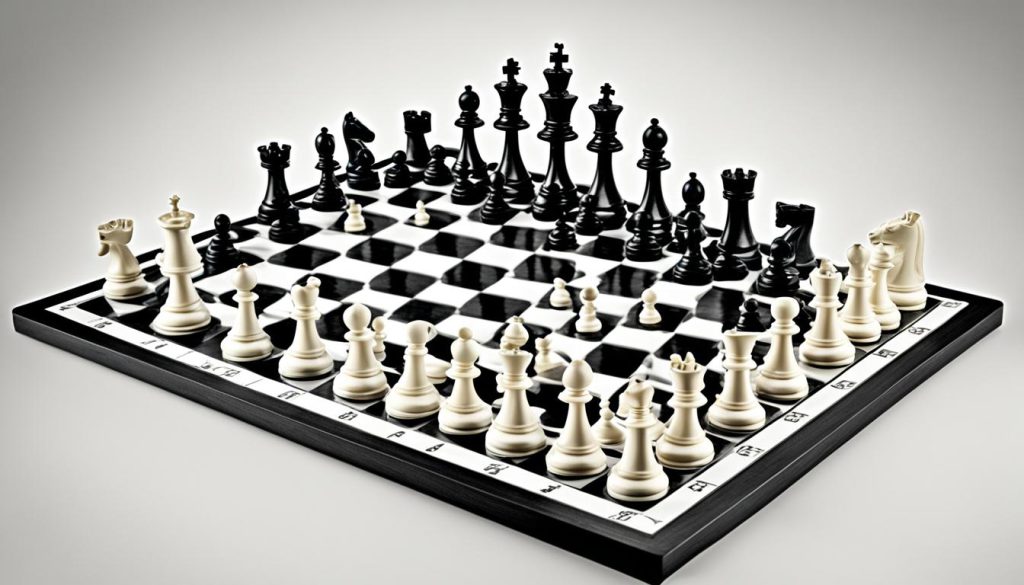Chess became much more popular during the COVID-19 lockdowns. Chess.com’s PogChamps tournament on Twitch in 2020 added to that. Big names like Grandmaster Hikaru Nakamura, xQc, and Ludwig drew huge crowds. Netflix’s “The Queen’s Gambit” also made more people play on Chess.com and Lichess.
Starting a chess game with good opening moves is key. These first moves shape your game plan. For new players, it’s better to learn the basic opening theories than to just memorize moves. This way, you won’t feel lost when things don’t go as planned. Chess.com is a great place to pick up and practice these basics.
Key Takeaways
- Effective chess opening moves can dictate the course of the entire game.
- Understanding essential chess opening theory is important for beginners.
- Events and media, such as PogChamps and “The Queen’s Gambit,” have significantly boosted the game’s popularity.
- Using platforms like Chess.com can help beginners practice and refine their opening strategies.
- Focus on strategic principles rather than rote memorization of moves for a better understanding of the game.
Introduction to Chess Opening Moves
Chess opening moves set the stage for the game. They are key for gaining control and moving smoothly into the middlegame. Knowing the basic principles behind these moves is crucial with so many possible sequences.
Importance of Opening Moves
The number of 20-move sequences in chess is in the billions. This shows the complexity and why mastering openings is vital. The top choices for White are the King’s Pawn Opening (1. e4) and Queen’s Pawn Opening (1. d4). These moves have deep strategy. For instance, 1. e4 is aggressive and was a favorite of chess legend Bobby Fischer.
Basic Opening Principles
Key principles in chess openings include:
- Piece Development: Get pieces into action quickly, controlling or aiming at the board’s center.
- Control of the Center: Owning the central squares (e4, d4, e5, d5) boosts mobility and strategic options.
- King Safety: Protecting your king, usually by castling, to avoid early attacks and secure a safe haven.
Less common openings include the English Opening (1. c4) and the Grob Opening (1. g4). These can catch opponents off guard but need more strategic knowledge.
In Queen’s Pawn openings, Black’s main responses are 1…d5 and 1…Nf6. Openings often lead to similar positions, giving players flexibility. Grouping chess openings helps with focused learning and analysis.
For more on chess openings and their strategies, visit Chess Pathways.
The Italian Game
The Italian Game is a classic chess opening from the 1500s. It’s loved by top players for its quick piece movement and control of the game’s center.
Opening Moves and Strategy
The Italian Game opens with the king’s pawn moving two squares, followed by specific moves (1.e4 e5 2.Nf3 Nc6 3.Bc4). It allows for fast development and central control. Different defenses can be used against it, like the Hungarian Defense, the Two Knights Defense, and the Giuoco Piano.

The Giuoco Piano lets Black challenge White’s control with moves such as d7-d5. In this variant, Black wins 31%, draws 33%, and loses 36% of games. If Black opts out of the Evans Gambit, the game takes a new turn, with Black winning 41%, drawing 23%, and losing 36%.
Historical Background
The Italian Game has a rich history. It was analyzed by chess masters like Giulio Cesare Polerio and Gioachino Greco in the 16th century. It’s still used by Grandmasters like Anish Giri and Wesley So today. This strategy shows how chess openings evolve, staying relevant and powerful.
Example Games
Many great matches have featured the Italian Game. For example, Anderssen vs. Dufresne (1852) offered a lesson in attacking play. Meanwhile, Steinitz vs. von Bardeleben (1895) showed strategic depth. Recent matches, like Carlsen vs. Nakamura (2011), demonstrate its ongoing relevance.
These games are valuable for studying chess openings and the Italian Game’s application. By exploring them, players can understand this opening’s intricacies better.
The Sicilian Defense
The Sicilian Defense is a favorite for players responding to White’s 1.e4 in chess. It is known for leading to games where the chances to attack are great for Black. This opening has been used by famous champions like Bobby Fischer, Garry Kasparov, Viswanathan Anand, Vladimir Kramnik, and Magnus Carlsen. They used it to challenge White’s control of the center.
Why Choose the Sicilian Defense
Choosing the Sicilian Defense can shift the odds in favor of Black. It creates an uneven pawn structure and opens the door for strong attacks. Unlike other openings, it aims to break down White’s control of the center and be proactive.
Using the Sicilian Defense means you’re applying advanced chess opening tactics. It pushes players to play boldly and creatively. Starting with 1…c5 allows Black to move into positions ideal for counterattacks and complex strategies during the middlegame.
Popular Variations
The Sicilian Defense has many variations to suit different strategies and styles. Here are a few key ones:
- Najdorf Variation: Loved by Fischer and Kasparov, it aims for quick development and control of central and queenside areas.
- Dragon Variation: It leads to fierce and complicated positions, with chances for explosive tactics.
- Classical Variation: This strategy focuses on getting the knights and bishop moving quickly to control the center and prepare for a counterattack.
- Alapin Variation: Less common, it challenges Black’s usual pawn setup, pushing them into new situations.
Each variant of the Sicilian Defense offers unique benefits. They give players various options based on how White and Black play, making the game of chess even more diverse.
Example Games
The Sicilian Defense’s value shines in games played by grandmasters. For example, Garry Kasparov’s use of the Najdorf Variation demonstrates its potential for counterplay and intricate middlegame situations.
Bobby Fischer’s games underscore the precision needed in the Dragon Variation. Control of important squares and tactical skills are crucial. Similarly, Mikhail Tal’s games show bold and innovative plays typical of the Sicilian Defense.
Here’s a quick overview of some popular Sicilian Defense variations:
| Variation | Key Features | Notable Players |
|---|---|---|
| Najdorf | Aims for rapid central and queenside control | Fischer, Kasparov |
| Dragon | Sharp attacking with opposite castles | Tal, Anand |
| Classical | Emphasizes rapid knight and bishop development | Carlsen, Taimanov |
| Alapin | Disrupts Black’s pawn structure | Kotov, Larsen |
By exploring these games, players can learn a lot about chess openings. They can see how games evolve from the start into complex and exciting middlegames.
The French Defense
Since the 1800s, the French Defense has been important for chess masters. It’s a top choice for responding to 1.e4. This strategy has a long history. It started with a game in 1834 between the London and Paris Chess Clubs. The French Defense creates strong, but closed pawn structures. It’s great for players who want a safe game with chances to counter-attack.

The French Defense has different parts: Advance, Exchange, Tarrasch, and Main Line (3.Nc3). Each part offers unique strategic challenges. The Advance Variation looks to control the center and constrain Black’s pawns, leading to tense games. It tends to favor White. The Exchange Variation creates a balanced structure, which is good for those who like strategic play over quick battles.
Looking into the Tarrasch Variation shows it’s less aggressive but still effective. It allows White a chance to safely gain a slight edge. Against the French Defense in the Tarrasch, White wins 42% of the time, draws 30%, and loses 28%, showing its balanced nature.
For players who love aggressive and tactical play, the Main Line of the French Defense stands out. It’s known for its bold and complex nature. This makes it a favored choice among players who enjoy intricate chess battles.
In the words of Grandmaster Viktor Korchnoi, “The French Defense is a test of patience and skill, rewarding those who dare delve deep into its intricate lines.”
Professionals often look at stats to get better at the French Defense. They study its different parts, success rates, ties, and common errors. Exploring this opening helps us understand its major role in chess strategy.
| Variation | Win Rate – White | Draw Rate | Win Rate – Black |
|---|---|---|---|
| Advance | 55% | 25% | 20% |
| Exchange | 45% | 35% | 20% |
| Tarrasch | 42% | 30% | 28% |
| Main Line (3.Nc3) | 50% | 20% | 30% |
Ruy-Lopez: A Classic Approach
The Ruy-Lopez is a top chess opening, with deep roots and historical importance. It’s called the Spanish Opening too, named after Ruy López de Segura, a Spanish bishop, from the 16th century. Its strategic depth offers many options and chances for both players, making it a favorite.
Opening Moves and Strategy
The Ruy-Lopez starts with 1. e4 e5 2. Nf3 Nc6 3. Bb5. This setup pressures Black’s knight and develops White’s pieces well. White aims to control the central e5 pawn while keeping the pieces tense.
In the Ruy-Lopez, strategies like the Berlin Defense and the Arkhangelsk Variation are notable. In the Berlin Defense, White wins 33%, draws 44%, and Black wins 22%. For the Arkhangelsk, White wins 39%, draws 30%, and Black wins 30%.
Historical Background
The Ruy-Lopez has been played at the highest chess levels for a long time. Systems like the Zaitsev Variation, by Anatoly Karpov, and the Keres System, by Nigel Short, made it popular. Max Euwe noted that trading White’s d4 pawn for Black’s e5 can favor White in endgames.
The Breyer System and the Smyslov Variation show the Ruy-Lopez’s depth. The Breyer System, by Gyula Breyer, moves Black’s knight to d7. It pressures e4 and maintains tension on the queenside.
Example Games
Learning from example games is key to mastering chess openings. Games by Garry Kasparov and Magnus Carlsen show the Ruy-Lopez’s potential. The Exchange Variation leads to imbalanced, opportunity-rich positions.
The Archangel Variation offers sharp play for both White and Black. Soviet players like Alexander Beliavsky and others favored it. It works to move the d-pawn to d4 and open the a-file for the rook.
The Ruy-Lopez includes the Closed Defense and dynamic systems like the Marshall Attack. It remains a leading chess opening. Players can find many advanced tactics to learn and use.
The Slav Defense
The Slav Defense stands as a strong response to White’s Queen’s Gambit. It ensures a reliable pawn structure and quick piece movement. It shines in master chess openings. Its complexity is vital for anyone looking to up their chess game.
Understanding the Slav Defense
The Slav Defense leads to games filled with essential chess opening theory. White wins 40% of these matches, draws 39%, and loses 21%. This shows the defense’s effectiveness. It focuses on keeping pawns safe and lets knights and bishops move freely. Greats like Euwe and Alekhine have used it, proving its value.
Popular Variations
Many versions of the Slav Defense match different styles:
- Exchange Variation: Often ends in a draw (65%), offering a complex but stable game.
- Bled Attack: A bolder line where White wins 48%, draws 32%, and loses 20%.
- Modern Line, Quiet Variation: Slightly better for White with wins at 49%, draws at 37%, and losses at 13%.
- Chameleon Variation with 5.c5: Makes games unpredictable, with White winning 41%, drawing 34%, and losing 24%.
Example Games
Looking at past games helps understand the Slav Defense’s power:
| Game | Variation | Outcome |
|---|---|---|
| Euwe vs. Alekhine (1937) | Standard Slav | White Victory |
| Topalov vs. Kramnik (2006) | Exchange Variation | Draw |
These matches highlight the Slav Defense’s role in chess strategy. They show how it influences game results.
Common Mistakes in Chess Opening Moves
Learning the dos and don’ts of chess openings can save your game from early disasters. It’s all about avoiding mistakes that can lead to a quick loss.
Avoiding Early Queen Moves
Many beginners wrongly move their queen too soon. This mistake makes the queen a target, losing valuable time. Pieces like knights and bishops should be your focus at the start.
Developing Pieces Efficiently
Good piece development means placing them in strong positions, especially near the center. A rookie mistake is moving a pawn in front of the rook early, which risks the rook.
Using tactics like the Noah’s Ark trap shows the danger of not having escape routes. This can secure an opponent’s bishop with smart pawn placement. But, copying your opponent too much can also lead you to bad positions, lacking in strategy.
Knowing great chess openings helps you move without blocking your pawns or needlessly risking rooks. You can avoid these pitfalls with a good understanding of chess openings.
| Common Mistake | Consequence |
|---|---|
| Fool’s Mate | Game lost after just two moves |
| Early Rook Push | Rook becomes vulnerable to attacks |
| Blocking Central Pawns | Limits central control and piece mobility |
| Excessive Move Copying | Ends up in unfavorable positions |
In summary, avoid these errors and stick to core chess opening strategies. This approach will boost your performance and build a strong foundation for your chess games.
Chess Opening Moves Guide
Approaching the game with confidence is key, whether you’re playing as White or Black. This guide will show you strategies for both. By doing so, you’ll start strong right from the start.
Playing as White
White’s favorite opening moves are 1. e4 and 1. d4. These are known as the King’s Pawn Opening and the Queen’s Pawn Opening. Bobby Fischer, a World Champion, loved the King’s Pawn Opening. He said it was the best. These moves help you control the center early on, making a strong start.
If you want to mix things up, try the English Opening (1. c4) or the Reti Opening (1. Nf3). They’re solid choices. There are also unique moves like The Bird Opening (1. f4), The Polish Opening (1. b4), and The Grob Opening (1. g4). These can surprise your opponent and give you an edge.
Playing as Black
As Black, your aim is to counter White’s early game advantage. Against the Queen’s Pawn Opening, responding with 1…d5 or 1…Nf6 works well. These moves challenge White’s control of the center.
The Sicilian Defense is a strong reply to 1. e4. It lets Black counterattack and disturb White’s plans. For those who like to play it safe, the French Defense establishes a solid, though closed, pawn structure.
Knowing these opening moves for both sides helps you develop strong chess strategies. With so many possible moves at the start, mastering these openings is challenging yet rewarding.
Conclusion
As we wrap up our journey in the chess world, it’s clear how vital the first moves are. We’ve looked at the Italian Game and the Sicilian Defense’s bold plays. These openings set the game’s tone, showing if it will be open or closed. The Najdorf Sicilian alone appears 15 times after 20 moves in the Chess.com database. This proves the depth and variety of chess strategies out there.
Both new players and pros encounter their own sets of challenges. Newbies might stumble in the beginning stages, while grandmasters must deeply know their openings to avoid early setbacks. Tools like Chessable and DecodeChess offer great learning aids. With over 1,000 opening variations, understanding the reasoning behind each move is key.
No matter if you prefer the Caro-Kann’s safety or the Nimzo-Indian’s complex tactics, certain strategies are always critical. These include pawn breaks, correct piece placement, and central control. By studying these openings and improving your methods, you can master advanced tactics. This foundation is crucial for later victories. Chess mastery is a mix of theory, practice, and the drive to uncover all its secrets.
Source Links
- https://gamerant.com/chess-best-opening-moves/
- https://chesspathways.com/chess-openings/
- https://www.chess.com/openings/Italian-Game
- https://simplifychess.com/italian-game/
- https://www.chess.com/openings/Sicilian-Defense
- https://simplifychess.com/sicilian-defense/
- https://www.chess.com/openings/French-Defense
- https://simplifychess.com/french-defense/
- https://www.chess.com/openings/Ruy-Lopez-Opening
- https://simplifychess.com/ruy-lopez/
- https://www.chess.com/forum/view/chess-openings/main-ideas-in-the-ruy-lopez
- https://www.chess.com/openings/Slav-Defense
- https://www.chessstrategyonline.com/content/tutorials/how-to-start-a-game-of-chess-opening-mistakes
- https://www.chess.com/terms/chess-openings
- https://decodechess.com/chess-openings-explained/
- https://www.chess.com/article/view/basic-opening-ideas

